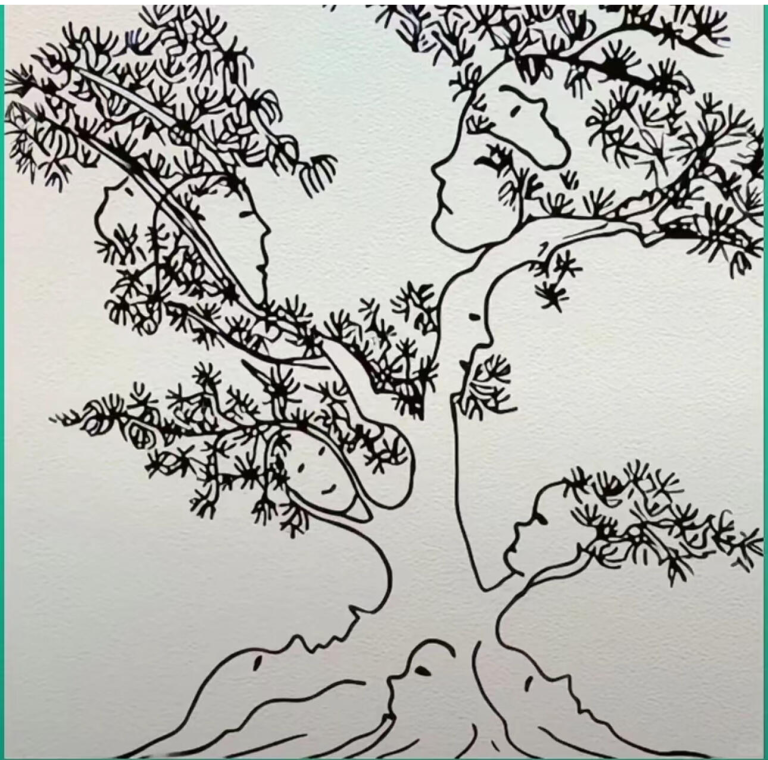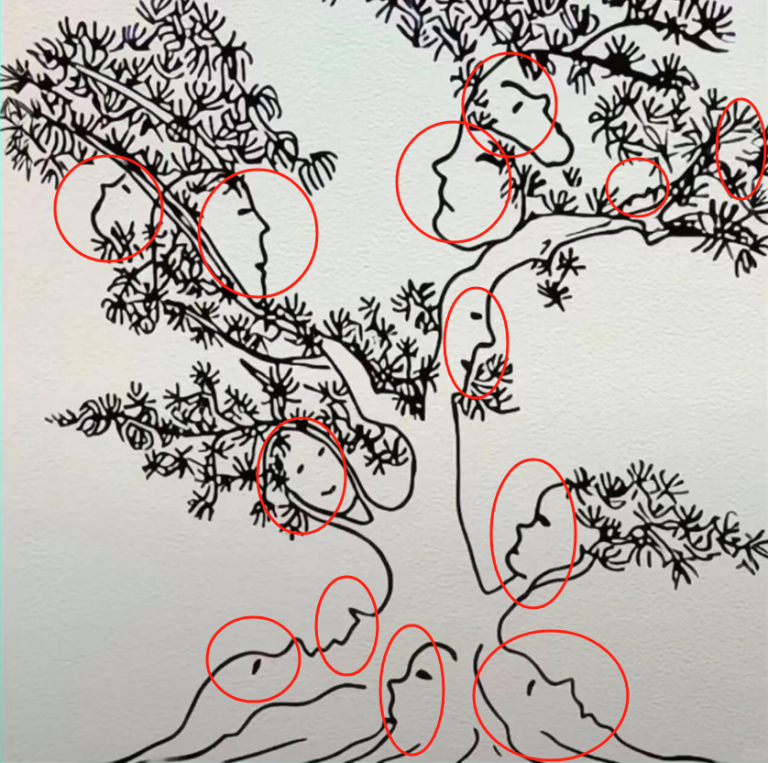Embracing the Hidden Faces of Nature: Optical Illusion Tree Art Unveiled
Unlocking the Mystery of Tree Face Illusions
Have you ever stared at the gnarled bark of an ancient tree and suddenly noticed a human face peering back? That delightful trick of perception—where branches and leaves bend into familiar shapes—is known as pareidolia. In this stunning ink illustration, a windswept tree reveals multiple faces seamlessly entwined in its trunk and foliage. Each profile emerges just long enough for you to blink and wonder, “Did I really see that?” Let’s dive into the art, science, and creative magic behind these hidden face arboreal masterpieces.

The Psychology Behind Pareidolia: Why We See Faces Everywhere
Our brains are hardwired to recognize faces—it’s a survival skill wired deep into our neural circuitry. When we encounter random patterns—clouds, rock formations, or tree bark—our fusiform face area leaps into action, matching curves and shadows to the template of eyes, noses, and mouths. This explains why:
- Emotional Connection: Spotting a face instantly triggers empathy and curiosity, making us pause and engage more deeply with our surroundings.
- Pattern Matching: Faced with visual ambiguity, the brain favors familiar shapes—faces—over random noise.
- Evolutionary Advantage: Early humans who quickly recognized friend or foe gained survival benefits, cementing face-detection pathways in our cortex.
By understanding pareidolia, we appreciate not just the art but the innate human response that brings each hidden visage to life.
From Cave Walls to Modern Canvases: A Brief History of Hidden-Face Art
Artists have been playing with dual images for centuries:
- Prehistoric Origins: CroMagnon cave paintings in Lascaux sometimes hide animal heads within abstract patterns—early experiments in visual ambiguity.
- Renaissance Revelry: Giuseppe Arcimboldo’s 16th-century portraits used fruits and vegetables to craft human likenesses, rewarding observant viewers.
- Victorian Stereograms: Intricate engravings hid miniature scenes or faces in ornate borders, delighting readers who peered intently.
- Surrealist Surprises: Dalí and Magritte blended dreamlike forms, encouraging multiple interpretations in a single canvas.
- Contemporary Illusions: Today’s illustrators draw on these traditions, using minimalist line work—like the tree from our image—to conjure hidden figures with startling simplicity.
This lineage shows that hidden-face art bridges eras, always engaging us with a playful “aha!” moment.

Decoding the Tree of Hidden Faces: What to Look For
When you first view our inkscape, you might see only a windswept tree. Here’s how to uncover each hidden profile:
- Trunk Contours: Follow the swooping lines of the trunk for chin and cheek outlines. Notice how knots become eyes if you let your gaze drift into the negative space.
- Branch Clusters: Clusters of pine-needle foliage often serve as hair or beards—scan the groupings for forehead and scalp shapes.
- Root Patterns: Gnarled root flares can morph into lower faces, each with unique expressions.
- InterFace Relationships: Faces appear to gaze at one another, creating silent conversations that invite you to piece together their stories.
- Scale Shifts: Some profiles are small—less than an inch—while others dominate a branch line. Move closer and farther away to catch them all.
By systematically exploring trunk, branches, and roots, you’ll discover all the whispered faces hiding in plain sight.

Techniques for Crafting Your Own Hidden-Face Tree Drawing
Eager to try this yourself? Here’s a beginner’s roadmap:
- Start with a Tree Silhouette: Block in the main trunk and major branches in pencil, focusing on a dynamic, windswept posture.
- Map Out Key Faces: Lightly sketch human profiles facing different directions—three-quarter views work best—within the trunk mass.
- Integrate Branches and Hair: Use branch lines to form hairlines and shoulders, weaving leaves into beards or crowns.
- Refine Line Quality: Switch to a fineliner or brush pen. Vary line weight—thick for main outlines, thin for facial details and foliage textures.
- Erase Guidelines: Once inked, remove pencil marks to let hidden faces meld naturally into the tree.
- Add Pine-Needle Textures: Dot or hatch foliage areas to evoke needles while maintaining open space for facial recognition.
Practice on scrap paper, and soon you’ll craft hidden-face trees that surprise friends and family alike.
Beyond Art: The Therapeutic Power of Illusion Drawing
Hidden-face illustrations aren’t just visually captivating; creating them offers real mental benefits:
- Mindfulness and Flow: The slow, deliberate process of sketching branches and faces can induce a meditative state, reducing stress.
- Enhanced Observation: Training your eye to spot subtle shapes spills over into everyday life—making you more attuned to details in nature and design.
- Creative Confidence: Solving the puzzle of how a face fits into knot and branch builds problem-solving skills and artistic boldness.
Whether you’re a seasoned artist or a curious beginner, illusion art invites you to slow down—one line at a time.

Displaying Your Illusion Art: Tips for Maximum Impact
Once your hidden-face tree is ready, show it off in style:
- Minimalist Framing: Choose a thin, black frame with a clean white mat to focus attention on the delicate line work.
- Strategic Lighting: Soft, angled lighting highlights ink textures and encourages viewers to scan the surface for hidden faces.
- Interactive Exhibitions: Invite friends to “spot the faces” with a gentle time limit, turning your living room into an immersive art game.
- Digital Teasers: Share progressive reveals on social media—zoomed-in shots of small faces to entice followers to discover the full image.
By curating the presentation, you turn a simple drawing into a memorable, participatory experience.

Conclusion: Celebrate the Dance Between Nature and Imagination
This windswept tree bursting with hidden faces reminds us that the boundaries between reality and perception blur beautifully in art. From our ancestral urge for face recognition to the playful ingenuity of illusionists across centuries, hidden-face tree drawings unite scientific curiosity, creative expression, and meditative practice. So grab your pencil, embrace a sense of wonder, and let each branch whisper its own secret profile—because in the dance of ink and imagination, every line carries the potential for surprise.





